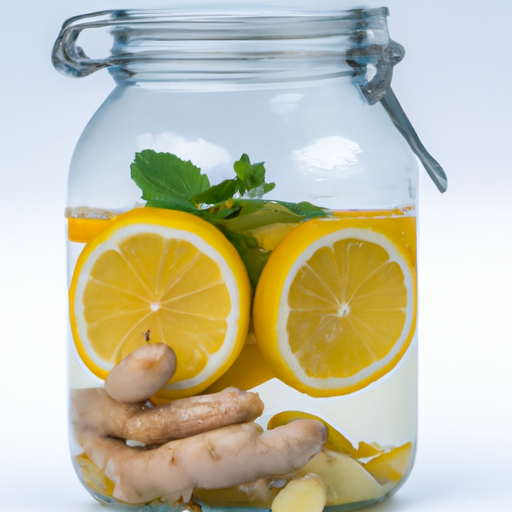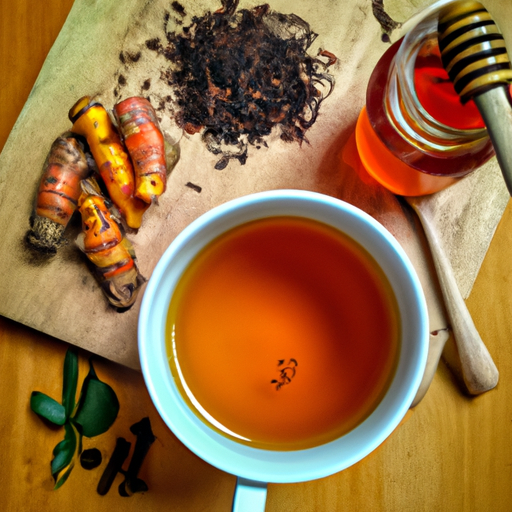Do you ever feel like your body could use a refresh? After dealing with stress, unhealthy food, and pollution, it’s important to give our bodies a detox, just like we clean our houses regularly. I have some good news for you!
And what better way to do that than by drinking a gallon of fresh ginger and turmeric tea? Not only does this tea taste delicious with its spicy yet sweet flavor, but it’s also packed with incredible health benefits.
Ginger has anti-inflammatory properties that can help reduce muscle soreness and joint pain. Meanwhile, turmeric is known for its high levels of antioxidants that can protect the body against free radicals. Together, they make a powerful duo that can boost your immune system and aid in digestion.
So let me guide you on how to make this beneficial beverage at home.
Key Takeaways
- Ginger and turmeric have strong anti-inflammatory properties that can help reduce inflammation throughout the body.
- Consuming foods or drinks high in antioxidants like ginger and turmeric can help reduce oxidative stress and protect our bodies from disease.
- Measuring the ingredients accurately is essential to make the perfect cup of ginger and turmeric tea.
- Straining is crucial for achieving a smooth texture and infusing flavors effectively.
Benefits of Ginger and Turmeric Tea
You’re going to love how ginger and turmeric tea can boost your health with their anti-inflammatory properties! The health benefits of these powerful roots have been known for centuries, and now modern science is confirming what many people already knew.
Ginger and turmeric have strong anti-inflammatory properties that can help reduce inflammation throughout the body. This makes them great for reducing pain, swelling, and stiffness associated with conditions like arthritis.
Additionally, studies have shown that ginger and turmeric may also be beneficial in reducing oxidative stress in the body. Oxidative stress is a natural process that occurs when the body produces free radicals as byproducts of normal metabolism. These free radicals can cause damage to cells and tissues over time, leading to chronic diseases like cancer, heart disease, and diabetes.
By consuming foods or drinks high in antioxidants like ginger and turmeric, we can help reduce this oxidative stress and protect our bodies from disease.
If you want to experience these amazing health benefits for yourself, let’s move on to the ingredients and equipment you’ll need to make a gallon of detox fresh ginger and turmeric tea!
Ingredients and Equipment
To whip up a batch of this invigorating elixir, all you’ll need are some quality roots and a sturdy blender. Here’s a list of ingredients and equipment recommendations to get you started:
| Ingredients | Amount |
|---|---|
| Fresh ginger root | 1 cup, peeled and chopped |
| Fresh turmeric root | 1 cup, peeled and chopped |
| Water | 1 gallon |
For equipment, you’ll need a large pot or kettle to heat the water and a high-speed blender to blend the ginger and turmeric into a smooth paste. I recommend using fresh roots instead of powdered forms for maximum health benefits.
Now that we’ve got our ingredients and equipment ready, let’s move on to preparing them for brewing.
Preparing the Ingredients
Once the roots have been peeled and chopped into small pieces, they can be added to the blender with water for a smooth consistency. To prepare ginger and turmeric tea, I usually follow these steps:
- I make sure to use fresh organic ginger and turmeric roots sourced from my local farmer’s market or grocery store.
- I rinse the roots thoroughly under running water before peeling them with a vegetable peeler.
- After peeling, I chop the roots into small pieces that will easily fit in my blender.
Finally, I add enough water to cover the ingredients before blending until smooth.
It is important to note that there are variations on this recipe depending on personal preference or availability of ingredients. Some people may choose to add lemon juice, honey, or other spices like cinnamon or black pepper for added flavor and health benefits. It’s also essential to source high-quality ingredients as they significantly impact the taste and effectiveness of the tea.
Moving forward into boiling the water, it’s crucial to ensure that you use filtered or purified water instead of tap water as it may contain chemicals that could affect its quality.
Boiling the Water
Now that the ingredients are prepared, it’s time to bring the water to a boil. The water temperature is important as it affects the taste and potency of the tea. Ideally, use filtered or spring water and bring it to a rolling boil at 212°F (100°C). It’s best not to heat the water in a metal pot as it can react with ginger and turmeric, altering their beneficial properties.
Boiling time is equally crucial in making this tea. A common mistake when boiling ginger and turmeric is overcooking them, which results in a bitter taste. To ensure optimal flavor extraction without destroying nutrients, boil for about 10-15 minutes on low-to-medium heat. Keep an eye on the pot while boiling as hot liquids tend to bubble up quickly and overflow. Once done, turn off the heat and let it cool down before adding ginger and turmeric slices.
With the water now at a perfect temperature and boiled for just enough time, we’re ready to move onto adding in our ginger and turmeric slices to create this delicious detox tea concoction.
Adding the Ginger and Turmeric
Now that the water’s boiling, it’s time to add in the ginger and turmeric.
First, I measure out the appropriate amounts of each ingredient according to my recipe.
Then, I carefully stir them into the pot of boiling water.
If desired, at this point I can also add in other optional ingredients such as lemon or honey for added flavor and health benefits.
Measuring the Amounts
Who knew making a gallon of detox fresh ginger and turmeric tea could be as easy as throwing in a few tablespoons of grated ginger and turmeric? Well, I didn’t until I learned about the proper measuring techniques. To make the perfect cup of ginger and turmeric tea, it’s essential to measure the ingredients accurately. Too much or too little can affect the taste and health benefits of your drink.
To make a gallon of detox fresh ginger and turmeric tea, you’ll need to measure out one cup (8 oz) of freshly grated ginger root and one cup (8 oz) of freshly grated turmeric root. You can adjust this recipe according to your preference by reducing or increasing the amount of these ingredients. The table below shows how different measurements will affect the strength and flavor profile of your tea.
| Amount | Ginger Flavor | Turmeric Flavor |
|---|---|---|
| 1/2 cup | Mild | Mild |
| 1 cup | Medium | Medium |
| 2 cups | Strong | Strong |
| 3 cups | Very strong | Very strong |
Now that we’ve covered measuring techniques and adjusting recipes let’s move on to adding other optional ingredients such as lemon or honey for added flavor.
Adding Other Optional Ingredients
To enhance the flavor and health benefits of your brew, you’ll want to consider adding in optional ingredients such as lemon or honey.
Lemon adds a refreshing tang to the tea while also detoxifying the liver and improving digestion.
Honey not only sweetens the drink but also provides antibacterial properties and soothes sore throats.
There are many other optional ingredients you can experiment with, such as cinnamon for added warmth or cayenne pepper for a spicy kick.
Feel free to get creative and find flavor variations that suit your taste buds. Once you’ve added your desired ingredients, it’s time to let the tea steep and infuse all those delicious flavors into the water.
Letting the Tea Steep
As if time wasn’t already moving slow enough, letting the tea steep for at least 30 minutes is crucial to fully infuse all the flavors. The longer you let it steep, the stronger and more potent the flavor profile will be.
Here are three reasons why I highly recommend letting your detox fresh ginger and turmeric tea steep:
-
Increased Nutrient Content: When you let your tea steep for a longer period of time, it allows more nutrients to be extracted from the ginger and turmeric roots, resulting in a more nutrient-dense beverage.
-
Enhanced Flavor: Allowing the tea to sit for an extended amount of time enhances its natural sweetness while minimizing any bitterness from certain ingredients such as ginger.
-
Relaxation Benefits: Sipping warm tea that has been allowed to steep can have a calming effect on both your mind and body.
After allowing your detox fresh ginger and turmeric tea to steep for at least 30 minutes, it’s time to strain it before enjoying!
Straining the Tea
Now that the detox fresh ginger and turmeric tea has steeped for a sufficient amount of time, it’s time to strain out the ingredients.
Using a fine mesh strainer is the best option to ensure that no small particles make their way into your cup.
It’s essential to remove all of the ginger and turmeric from the tea to prevent bitterness or overpowering flavors in each cup.
Using a Strainer
Firstly, it’s important to strain the freshly grated ginger and turmeric before adding it to the water in order to achieve a smooth and enjoyable texture. Straining helps remove any impurities or fibers that might make the tea gritty or difficult to drink. Additionally, straining is crucial for infusing flavors into the water effectively.
There are various alternative straining methods you can use depending on what you have available. For example, you may use a cheesecloth, fine mesh strainer, coffee filter, or a nut milk bag. Each of these options will effectively separate the pulp from your tea while still allowing all the healthy nutrients and rich flavors of ginger and turmeric to come through.
Once you’ve strained your tea using your preferred method, it’s time to move onto removing the ginger and turmeric from your gallon of detox fresh ginger and turmeric tea.
Removing the Ginger and Turmeric
To separate the solids from the liquid, sieve the mixture through a strainer of your choice. While using a traditional mesh strainer is the most common method for removing ginger and turmeric, there are alternative straining methods that you can try. One option is to use a cheesecloth or nut milk bag to strain out any remaining bits of ginger and turmeric. This method may take longer than using a mesh strainer but will result in a smoother, sediment-free tea.
Another benefit of leaving ginger and turmeric in your tea is that it allows for more nutrients to be infused into the water. Ginger and turmeric both contain powerful anti-inflammatory properties that can aid digestion, reduce inflammation in the body, and boost immune function. By leaving some of these solids in your tea, you’ll reap even more health benefits from this detoxifying beverage.
When you’re happy with the consistency of your tea, it’s time to move onto storing it properly.
Storing the Tea
When storing the detox fresh ginger and turmeric tea, make sure to place it in an airtight container and refrigerate it promptly so that you can enjoy it for up to a week. This will help preserve the freshness of the tea and prevent any bacteria from growing.
Additionally, if you notice any mold or strange odor coming from the tea, discard it immediately as this could indicate spoilage.
To extend the shelf life of your detox tea even further, you can also freeze it in ice cube trays. This is especially useful if you want to have access to a quick cup of detox tea without having to go through the entire process every time. Simply pop out one or two cubes and let them thaw before enjoying your refreshing drink.
Now that we’ve covered storing tips, let’s move on to serving the tea with some helpful suggestions!
Serving the Tea
Wow your taste buds with a deliciously zesty and invigorating beverage by following these simple suggestions for serving this heavenly concoction.
Firstly, make sure to strain the ginger and turmeric tea before serving it into individual cups or glasses. This will ensure that any loose bits of ginger or turmeric are removed, resulting in a smooth and enjoyable drinking experience.
Secondly, consider adding some honey or agave syrup to sweeten the tea if desired. Not only will it enhance the natural sweetness of the ginger and turmeric, but it can also help balance out any bitterness that may be present.
Lastly, garnish each cup with a sprig of fresh mint or a slice of lemon for an added touch of flavor and visual appeal.
When serving this detox fresh ginger and turmeric tea, keep in mind that presentation is key. Try experimenting with different types of teacups or glasses to elevate the overall aesthetic of your drink. Whether you choose a traditional ceramic mug or opt for a trendy clear glass jar, there are endless possibilities when it comes to tea presentation ideas.
By implementing these tea serving tips and incorporating your own personal touches, you can create an unforgettable drinking experience that is both delicious and visually stunning. So go ahead – sip away on this refreshing elixir while basking in its many health benefits!
Frequently Asked Questions
Can I use ground ginger and turmeric instead of fresh?
Yes, powdered ginger and turmeric can be used instead of fresh. However, the taste may differ slightly and adjustments to the recipe should be made accordingly. Follow recommended quantities on spice labels for best results.
How long can I store the tea for?
Storing instructions for ginger and turmeric tea involve refrigeration in an airtight container. Shelf life varies, but it can last up to 3-4 days before losing potency. Proper storage is crucial for maintaining freshness and health benefits.
Can I add honey or lemon to the tea?
Honey vs. Lemon: Which is the Best Addition to Your Detox Ginger and Turmeric Tea? Both have their benefits. Honey adds sweetness and antimicrobial properties while lemon provides vitamin C and aids digestion. Drinking detox ginger and turmeric tea with honey or lemon can boost immunity, reduce inflammation, aid weight loss, and improve overall health.
Can I make a smaller or larger batch of the tea?
Yes, adjusting serving size is possible by altering the amount of ingredients used. Ingredient substitutes can also be utilized as long as they have similar detoxifying properties. It’s important to maintain correct ratios for optimal benefits.
What are some potential side effects of consuming ginger and turmeric tea?
Potential side effects of consuming ginger and turmeric tea include digestive discomfort such as bloating and gas. Turmeric may also act as a blood thinner, so those taking anticoagulant medications should consult with their healthcare provider before drinking the tea.
Conclusion
In conclusion, making a gallon of detox fresh ginger and turmeric tea is easy and beneficial for your health. This tea has anti-inflammatory properties that can help reduce joint pain, improve digestion, and boost your immune system. The combination of ginger and turmeric creates a powerful antioxidant drink that helps to fight free radicals in the body.
To make this tea, you’ll need some basic ingredients such as fresh ginger root, turmeric powder or root, honey or agave nectar, lemon juice, and water. You can add other ingredients like cinnamon sticks or black pepper to enhance the flavor.
As the saying goes, "An apple a day keeps the doctor away,"but drinking this detox tea every day could also keep you healthy. So why not give it a try? Your body will thank you for it!










